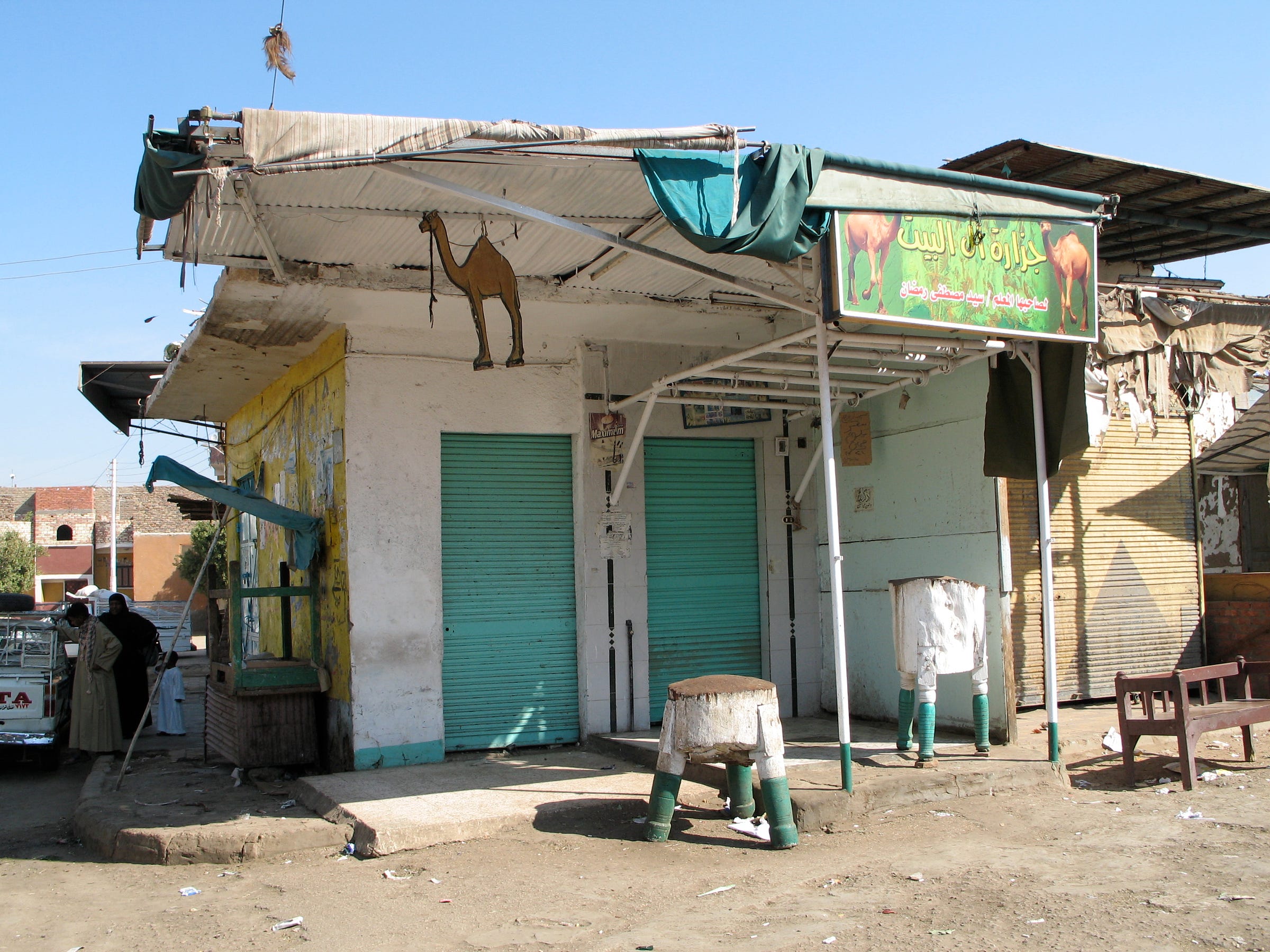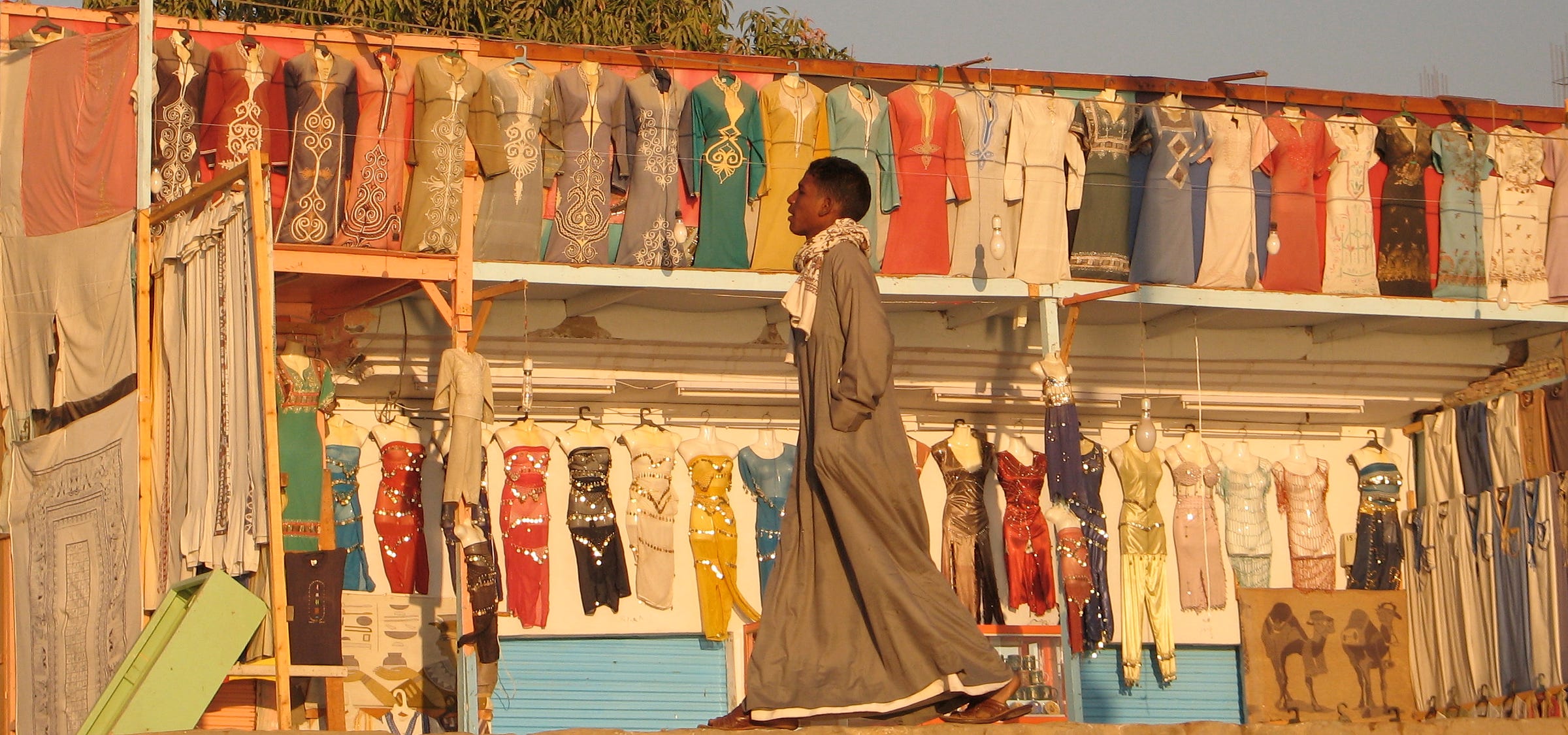We are moored in the moonlight on the beach of the tiny island of Horybyabab, guarded by the four dogs who call it their own. The islanders’ livestock have lain down for the night safely tethered in their palm frond pens after being herded there by their donkey riding master. To the East there’s a massive stand of bullrushes, to the North a magnificent mango grove whose irrigation channels are fed by an ancient water wheel, to the south a second dahabiya also tied up for the night and to the west the palm covered West Bank of the Nile with the inky black desert beyond. It could be an illustration from a child’s bible, and yet here we are huddled together for warmth on the top deck under rugs, sharing a bottle of wine and enjoying a dram or two of Jameson’s. It’s a scene more or less repeated for the four nights we have spent on ‘The Royal Cleopatra’, but it’s this first one I will remember most vividly.
The next morning I was up before the crew and watched the sunrise deckside, before walking gently across the island as the livestock woke up and the dogs lazily stretched.
Returning to the boat as our cook and crew were completing their morning ablutions in the river, our sails were soon hoisted and we were underway as breakfast was served in the galley- a spread of salads, cheeses, warm flatbreads and fried eggs, served with a generous helping of Ful Medames, that Nubian mashed fava bean staple, we had enjoyed so much on the West Bank in Aswan.
There’s just ten of us on board- Sabrina, our daughter, two dear friends from London, plus cook, crew and guide. Our quarters are definitely on the spartan side- a far cry from the fever dream ‘1001 nights’ opulence you’ll find on some of the luxury cruisers.
Not that we’d have it any other way. Twin-masted, barge-like sailing vessels like our dahabiya have been around in one form or another for thousands of years, with similar craft depicted on the walls of many Pharaonic tombs and they were the standard vessel for archaeologists and tourists alike until the 1870s. It’s wonderful to see them making a bit of a comeback for Nile travellers seeking a more authentic river voyage experience.
The southerly breeze had been so stiff as we left Elephantine Island in Aswan that hoisting the sails was initially impossible and we had to be towed by our motorised tugboat ‘King Tarek’, picking up a stranded felucca en route, but from then onwards we have been able by and large to tack our way down river.
The second day’s highlight was meant to be the riverside temple of Kom Ombo, but it is overrun by cruise boat hordes and marred by incessant cries of “Hello! Money!”. Far more interesting was our completely unmolested exploration of the small East bank town of Darow, with its camel market and (horrifyingly) camel meat butchers.
We also visited the ancient mud brick Nubian house of Beit al-Kenzi, which is thatched with dom palm leaves and has a ‘kitchen’ that again looks like an old testament illustration.
While we were chatting away with the camel vendors, it was clear from his anxious reaction that we are becoming more and more of a handful for our poor guide Mohamed, whose initial enthusiasm has turned to sheepish diffidence as one of our friend’s twin superpowers- his fluency in Arabic and his ability to read hieroglyphics, both come increasingly into play.
Back underway, we moor further upstream on Gebel Silsileh island in the gloaming, after an extraordinarily beautiful sunset and will visit its sandstone quarries, used by Rameses 1st to build the massive temple of Karnak, at sunrise tomorrow before the crowds gather. There are a half dozen other dahabiyas moored close by, a heartening sign that this mode of travel really is making a comeback.
The same pattern is repeated at our final stop in Edfu. Initially things look promising as we dock soon after sunrise right next to a stunningly colourful clothes market and there is not a cruise ship in sight.
Just over an hour later we visit the Temple of Horus- a beautifully preserved Greek replica of a Pharaonic structure and find it already rammed with superannuated, fanny pack toting tours. Finding a quiet corner, we listen enthralled as our friend tells us the story of the ‘Sacred Drama’- the conflict between Horus, the deity of the fertile lands adjacent to the mother river, and Seth the god of the surrounding desert, as Horus seeks revenge for the murder of his father, Osiris.
Further adding to Mohamed’s discomfiture we then set off for an unscheduled exploration of the town and a final lunch before we returned to disembark and travel by road to Luxor.
Exiting the souk, Sabrina is drawn by the most delicious smell of frying and we enjoy the meal of the voyage, deep fried bright green Ta’amiya (falafel) served with pita bread, onions and tahini on a long table set up with hookahs for an afternoon’s smoke. Such a pity we were on a deadline.
Ta’amiya (Green Falafel)
I was amazed by these falafel having only ever seen them made with chick peas. When you bite into them they are bright green!
2 cups dried broad (fava) beans, soaked overnight
1/2 cup fresh dill
1/2 cup coriander
1/2 cup of coriander
2 medium onions roughly chopped
10 cloves garlic
1 small leek (white parts only), cleaned and roughly chopped
1 tsp sodium bicarbonate
1 tsp ground cumin
Salt and pepper to taste
EV oil for frying
In a food processor add the drained beans with the herbs, leek and onions. Process until it forms a paste, then add the spices, seasonings and sodium bicarbonate, processing again to combine. Transfer the mixture to a bowl and set aside for one hour.
Scoop small amounts to form a series of approximately 5x2cm thick ‘disc’ and sprinkle one side with sesame seeds. Deep fry in hot oil until brown.
Serve warm or at room temperature.
As last night’s near full moon appeared over the mud brick houses, palm groves and alfalfa fields of El Fazawa, our very last island mooring and the muezzin called the faithful to prayer, we sat on deck for one last time as the scene faded to black and vowed to return to complete the journey to the Nile delta.
Egypt has an ancient connection with the annual Carnival celebrations which reach their peak this weekend so I want to take this opportunity for a shoutout to a favourite fellow writer of ours, who also publishes on Substack.
Sinù Fogarizzu’s ‘Dash of Prosecco” is a must read if you love the culture and food of the Veneto region. In her forthcoming post, which she will be publishing this Sunday 19th February she will tell the story of this connection, (clue, it is a signature deep fried treat intrinsically associated with the Venice Carnival). Don’t miss it!
Subscribe to Nomad Foodies
Recollections & recipes from six continents























Arguably Marco's most atmospheric narrative yet - and the bar is high! Pity you missed out on those hookahs, though. Deadlines, like records, are there to be broken.
It sounds like you had a truly memorable journey! Recently I read Murder on the Nile by Agatha Christie, your words brought back impressions of that elegant trip (minus the murder!).
Thank you for mentioning Dash of Prosecco, I look forward to share my findings (and recipe) this Sunday :)